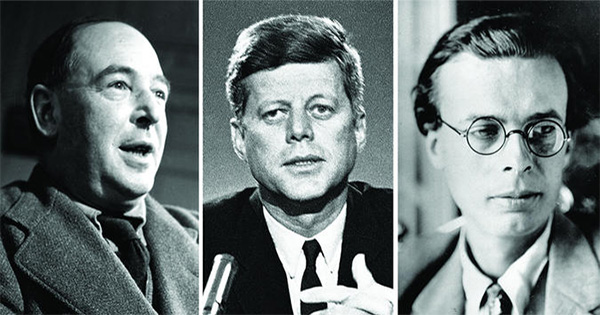Eclipsed in death: C. S Lewis and Aldous Huxley died on the same day as John F. Kennedy. On any ordinary day, the death of either author would make headline news but the 22nd of November 1963 wasn’t an ordinary day.

22 November 2022 – Each time this date comes around I think of that day in 1963 and the death of C. S. Lewis that occurred in his home in Oxford, England at 5:30 pm, followed an hour later by the death of John F. Kennedy, followed, seven hours after that, by the death of Aldous Huxley. Three giants, all gone in the blink of an eye. And I am acutely aware that millions of non-famous people also die each day of every year, many of them also giants in someone’s eyes.
Unsurprisingly, there are many notable letters related to these events – not least Laura Huxley’s account of her husband’s death, which can be read here. But my favorite, for want of a better word, has to be the following one, as it shines a light on one of history’s most discussed episodes, but from a different angle. It is also, quite simply, a fantastic piece of correspondence given the masturbatory hysterics and bullshit dramas we are subjected to every day.
On November 22, 1963, as he travelled by motorcade through Dealey Plaza in downtown Dallas, the 35th President of the United States, John F. Kennedy, was killed by the bullets of a sniper; one of Kennedy’s travelling companions, the Governor of Texas, John Connally, was also injured.
Five days later, Charles Jack Price, then-Administrator of Parkland Memorial Hospital in Dallas, proudly wrote to all staff and made clear his appreciation for their professional conduct over the past week – a period during which, as the world’s population looked on in abject horror, the hospital had dealt with the deaths of two people in particular on its premises: John F. Kennedy, and his accused assassin, Lee Harvey Oswald. Here is the letter, followed by my transcript should you find it difficult to read:

November 27, 1963
To: All Employees
At 12:38 p.m., Friday, November 22, 1963, President John F. Kennedy and Texas’ Governor John Connally were brought to the Emergency Room of Parkland Memorial Hospital after being struck down by the bullets of an assassin.
At 1:07 p.m., Sunday, November 24, 1963, Lee. H. Oswald, accused assassin of the late president, died in an operating room of Parkland Memorial Hospital after being shot by a bystander in the basement of Dallas’ City Hall. In the intervening 48 hours and 31 minutes Parkland Memorial Hospital had:
1. Become the temporary seat of the government of the United States.
2. Become the temporary seat of the government of the State of Texas.
3. Become the site of the death of the 35th President.
4. Become the site of the ascendency of the 36th President.
5. Become site of the death of President Kennedy’s accused assassin.
6. Twice become the center of the attention of the world.
7. Continued to function at close to normal pace as a large charity hospital.
What is it that enables an institution to take in stride such a series of history jolting events? Spirit? Dedication? Preparedness? Certainly, all of these are important, but the underlying factor is people. People whose education and training is sound. People whose judgement is calm and perceptive. People whose actions are deliberate and definitive. Our pride is not that we were swept up by the whirlwind of tragic history, but that when we were, we were not found wanting.
C. J. Price
Administrator